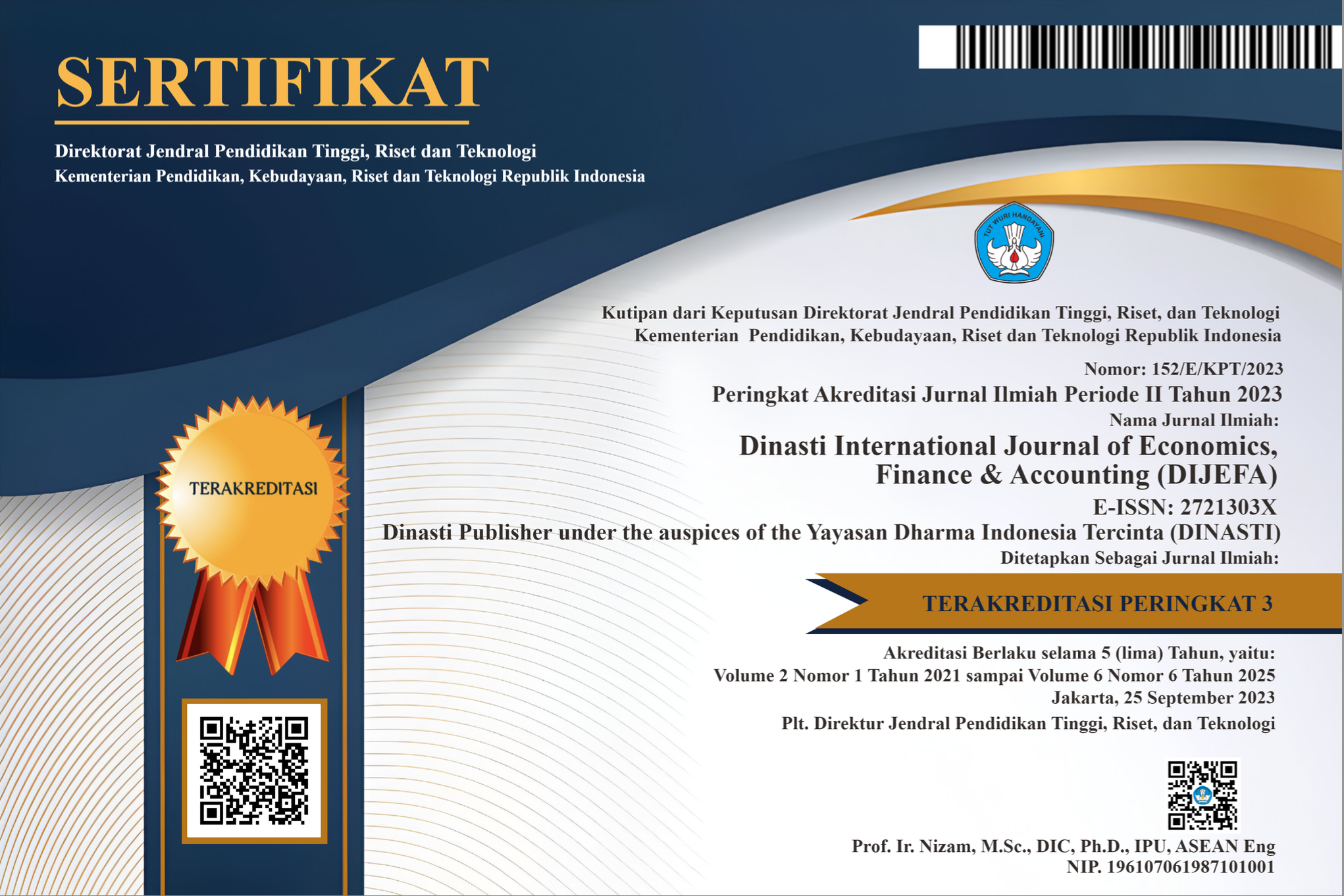Firm Life Cycle and Cash Policy
DOI:
https://doi.org/10.38035/dijefa.v4i2.1738Keywords:
Cash Policy, Life Cycle of the Firm, Panel DataAbstract
This study aims to examine how the stages of the company's life cycle affect the company's cash policy. This study focuses on the stages of the firm's life cycle which includes the cycle stages of introduction, growth, maturity and shakeout against cash policies adopted by the company. This research is considered important because cash policy is influenced by company characteristics, namely the life cycle in which the determination of the company's life cycle is based on cash flow from operating, investing, and financing activities. This study uses panel data regression with a sample of the companies selected are manufacturing companies listed on the Indonesia Stock Exchange with an observation period from 2014-2019. By using a sample of 90 manufacturing companies, the results prove that the company has a large enough cash balance when the company is in the mature and shakeout cycle stages, while the introduction and growth cycle stages do not prove that the cash balance will be greater or less
References
Allayannis, G., & Mozumdar, A. (2004). The impact of negative cash flow and influential observations on investment-cash flow sensitivity estimates. Journal of Banking and Finance, 28(5), 901–930. https://doi.org/10.1016/S0378-4266(03)00114-6.
Almeida, H., Campello, M., & Weisbach, M. S. (2004). The Cash Flow Sensitivity of Cash. The Journal of Finance, LIX(14), 1777–1803.
Alti, A. (2003). How Sensitive Is Investment to Cash Flow When Financing Is Frictionless? Journal of Finance, 58(2), 707–722. https://doi.org/10.1111/1540-6261.00542.
Alzoubi, T. (2013). Corporate Cash-Holding Decisions : Amman Stock Exchange. Brunel University. https://doi.org/10.13140/RG.2.2.16639.15528.
Alzoubi, T. (2015). How Does Cash Holding Affect the Firm’s Investment Decisions? Evidence from Jordan. World Journal of Social Sciences, 5(3), 58–67.
Alzoubi, T. (2016). The Value of Cash Holding and the Financial Crisis : Evidence from Jordan. Dirasat Administrative Sciences, 43(1), 325–333. https://doi.org/10.12816/0028466.
Alzoubi, T. (2019). Firms’ life cycle stage and cash holding decisions. Academy of Accounting and Financial Studies Journal, 23(1).
.Bulan, L. T., & Yan, Z. (2010). Firm Maturity and the Pecking Order Theory. International Journal of Business and Economics, 9(3), 179–200. https://doi.org/10.2139/ssrn.1760505.
Dickinson, V. (2011). Cash Flow Patterns as a Proxy for Firm Life Cycle. Accounting Review, 86(6), 1969–1994. https://doi.org/10.2308/accr-10130.
Carpenter, R. E., & Guariglia, A. (2008). Cash flow, Investment, and Investment Opportunities: New Tests using UK Panel Data. Journal of Banking and Finance, 32(9), 1894–1906. https://doi.org/10.1016/j.jbankfin.2007.12.014.
Dittmar, A., & Mahrt-Smith, J. (2007). Corporate Governance and the Value of Cash Holdings. Journal of Financial Economics, 83(3), 599–634. https://doi.org/10.1016/j.jfineco.2005.12.006.
Drobetz, W., Halling, M., & Schrrder, H. (2015). Corporate Life-Cycle Dynamics of Cash Holdings. Swedish House of Finance Research Paper. https://doi.org/10.2139/ssrn.2578315.
Fama, E. F., & French, K. R. (2005). Financing decisions: Who issues stock? Journal of Financial Economics, 76(3), 549–582. https://doi.org/10.1016/j.jfineco.2004.10.003.
Faulkender, M. W. (2002). Cash Holdings Among Small Businesses. SSRN Electronic Journal. https://doi.org/10.2139/ssrn.305179.
Fazzari, S., Hubbard, R., Petersen, B., Blinder, A., & Poterba, J. (1988). Financing Corporate Constraints Investment. Brookings Institution Press, 1988(1), 141–206. Retrieved from http://www.jstor.org/stable/2534426.
Ferreira, M. A., & Vilela, A. S. (2004). Why Do Firms Hold Cash? Evidence from EMU Countries. European Financial Management, 10(2), 295–319. https://doi.org/10.1111/j.1354-7798.2004.00251.x.
Frésard Laurent, L., & Salva, C. (2010). The Value of Excess Cash and Corporate Governance: Evidence from US Cross-Listings. Journal of Financial Economics, 98(2), 359–384. https://doi.org/10.1016/j.jfineco.2010.04.004.
Gort, M., & Klepper, S. (1982). Time Paths in the Diffusion of Product Innovations. The Economic Journal, 92(367), 630–653. https://doi.org/10.2307/2232554.
Griffin, J. 2002. Customer Loyalty How to Earn It, How to Keep It. Kentucky: McGraw Hill.
Habib, A., & Hasan, M. M. (2015). Firm Life Cycle, Corporate Risk-Taking and Investor Sentiment. Accounting and Finance, 57(2), 465–497. https://doi.org/10.1111/acfi.12141.
Harford, J., Mansi, S. A., & Maxwell, W. F. (2008). Corporate Governance and Firm Cash Holdings in the US. Journal of Financial Economics, 87(3), 535–555. https://doi.org/10.1016/j.jfineco.2007.04.002.
Hasan, M. M., Al-Hadi, A., Taylor, G., & Richardson, G. (2016). Does a Firm’s Life Cycle Explain Its Propensity to Engage in Corporate Tax Avoidance? European Accounting Review, 26(3), 469–501. https://doi.org/10.1080/09638180.2016.1194220.
Haw, I. M., Ho, S. S. M., Hu, B., & Zhang, X. (2011). The Contribution of Stock Repurchases to The Value of The Firm and Cash Holdings around The world. Journal of Corporate Finance, 17(1), 152–166. https://doi.org/10.1016/j.jcorpfin.2010.10.001.
Jensen, M. (1986). American Economic Association Agency Costs of Free Cash Flow, Corporate Finance, and Takeovers. American Economic Review, 76(2), 323–329.
Kalcheva, I., & Lins, K. V. (2007). International Evidence on Cash Holdings and Expected Managerial Agency Problems. The Review of Financial Studies, 20(4), 1087–1112.
Kaplan, S. N., & Zingales, L. (1997). Do Investment-Cash Flow Sensitivities Provide Useful Measures of Financing Constraints. The Quarterly Journal of Economics, 112(1), 169– 215.
Kotler, P. (2002). Manajemen Pemasaran. Jakarta: Prenhalindo.
Miller, D., & Friesen, P. H. (1984). A Longitudinal Study of the Corporate Life Cycle. Management Science, 30(10), 1161–1183. Retrieved from http://www.jstor.org/stable/2631384.
Mulyadi. (2001). Management Accounting edition 3. Jakarta: Salemba Empat.
Pinkowitz, L., Stulz, R., & Williamson, R. (2006). Does the Contribution of Corporate Cash Holdings and Dividends to Firm Value Depend on Governance? A cross-Country Analysis. Journal of Finance. https://doi.org/10.1111/j.1540-6261.2006.01003.x.
Schnure, C. (1998). Who Holds Cash? And Why? Economist, Federal Reserve Board. https://doi.org/10.17016/feds.1998.13.
Takeo Hoshi, Kashyap, A., & Scharfstein, D. (1991). Corporate Structure, Liquidity, and Investment: Evidence from Japanese Industrial Groups. The Quarterly Journal of Economics, 106(33–60).
Tong, Z. (2011). Firm Diversification and The Value of Corporate Cash Holdings. Journal of Corporate Finance, 17(3), 741–758. https://doi.org/10.1016/j.jcorpfin.2009.05.001.
Vidiastuty, Deshinta. (2012). Effect of Company Life Cycle on Acquisition Activities. thesis. Jakarta. Master of Management Study Program, Specializing in Financial Management, Faculty of Economics, University of Indonesia.
Downloads
Published
How to Cite
Issue
Section
License
Authors who publish their manuscripts in this journal agree to the following conditions:
- The copyright on each article belongs to the author(s).
- The author acknowledges that the Dinasti International Journal of Economics, Finance & Accounting (DIJEFA) has the right to be the first to publish with a Creative Commons Attribution 4.0 International license (Attribution 4.0 International (CC BY 4.0).
- Authors can submit articles separately, arrange for the non-exclusive distribution of manuscripts that have been published in this journal into other versions (e.g., sent to the author's institutional repository, publication into books, etc.), by acknowledging that the manuscript has been published for the first time in the Dinasti International Journal of Economics, Finance & Accounting (DIJEFA).


























































